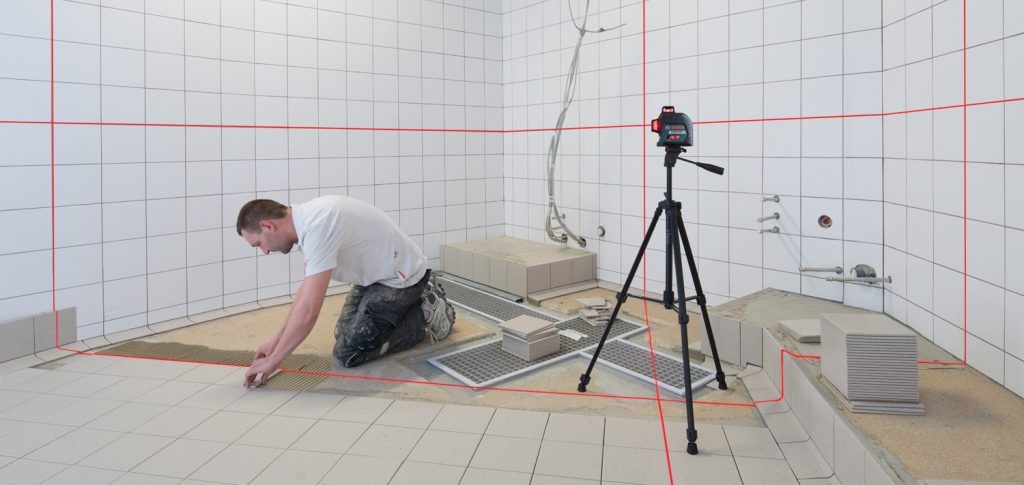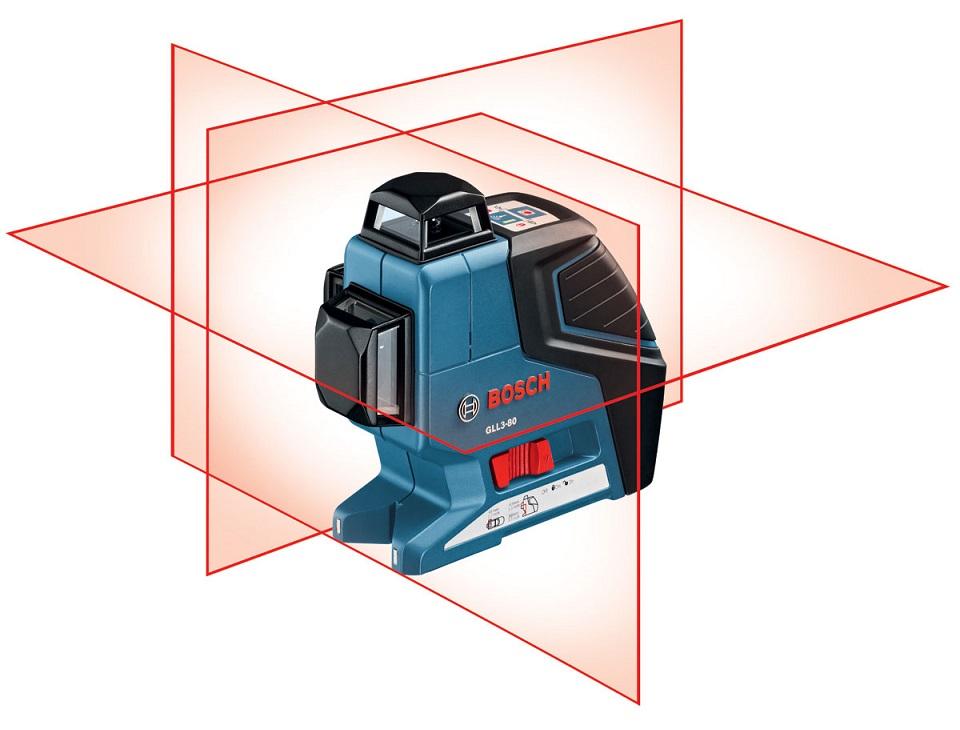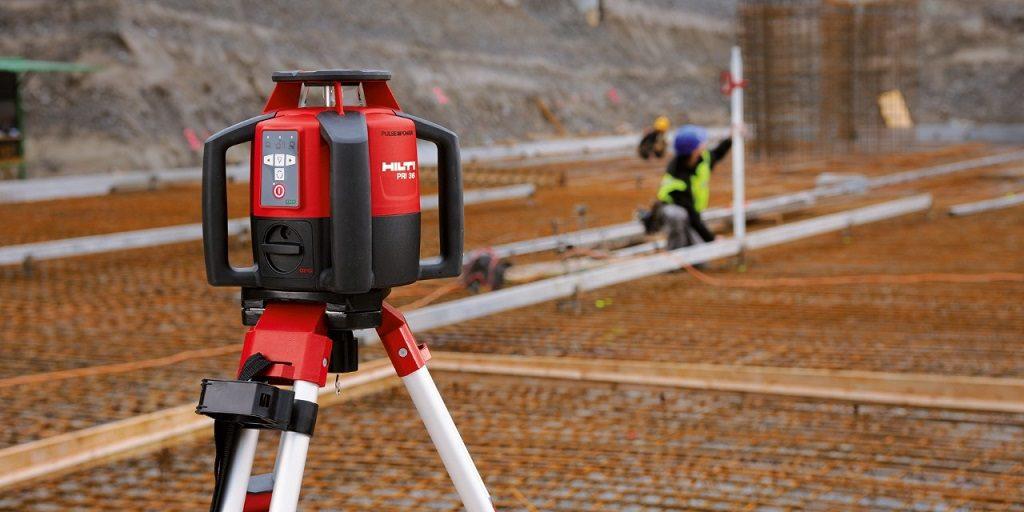A laser level is a very useful tool for carrying out various repair and construction work in a house, apartment or on a construction site. The device projects line or point markings with maximum accuracy on any vertical or horizontal surface.
Before deciding which option to buy, the user should know how to choose a laser level for home or construction, what functions it should have. Professionals in the field of construction and repair recommend choosing equipment in accordance with the specifics of the work, or stopping at a universal layout.
Content
What are the types of laser levels
All laser levels are classified according to the type of projection of lines or points on a plane. The right decision would be to choose a suitable model according to these criteria - they determine the range of work performed.

Types of laser levels:
- linear;
- point;
- rotary;
- combined.
Linear

Linear laser levels have gained the greatest popularity - they are very convenient for renovating an apartment or house, as well as for interior design. The devices operate in three modes: vertical, horizontal or cross projection with an angle of 90 degrees. Some models, such as ADA 3D Liner 2V, 3V or 4V, can project 2, 3 or 4 vertical planes. The disadvantage of linear laser levels is a small sweep, this parameter indicates the marking angle (how much the beam captures adjacent planes - for the vertical it is the floor and ceiling, for the horizontal - the left and right wall).
Point

Point-type models are considered the simplest, they are intended for point marking or point transfer. A distinctive feature of these laser levels is a long range, about 50 m. Depending on the specific modification, the device can project a point onto several planes: left and right, up and down, straight. The most popular are the 4-point models, which optimally combine an affordable price and a large area of application.
Rotary

Rotary lasers are equipment for professional work, these models are able to project vertical and / or horizontal 360 degrees around their axis. Technique of this type can be immediately distinguished by its design, the laser is placed not in the center, but in the upper part of the body. In addition, they are somewhat larger in size and 2-3 times heavier than linear ones. Often, rotary laser levels are equipped with a built-in battery and can operate autonomously for about 30-35 hours. The functionality of top-end technology is expressed in a price that is at least 2 times higher than linear and point modifications of its class.
Combined
Devices of a combined type combine the capabilities of linear, rotary and point, therefore, they are able to project both planes and points. These are the most functional and versatile types of laser levels.Moreover, there are both budget options (vertical / horizontal plus points up and down) and more advanced ones that are able to do everything.
How to choose a laser level - the main parameters

The main criterion for the correct choice of a laser level is the type of device; the suitable model is easy to determine if you analyze the area of the forthcoming work.
Experts note a number of the most significant technical characteristics that significantly affect the quality of the work performed and, accordingly, the result:
- range
- alignment type of markup
- number of rays
- type of laser - for external or internal work
Among the design features of this type of measuring devices, one should pay attention to the type of power supply, dimensions, weight.
For simple work, such as redecoration, installation of hanging furniture, shelves, paintings or appliances on the walls, installation of suspended or suspended ceilings, any linear model is suitable. Compact, inexpensive, with a simple design, the levels are quite convenient, here it is enough to correctly calculate the marking range.
Carrying out construction and repair work in large premises will require the use of a more functional laser level. The standard scan angle of 120-150 degrees is not enough, it is optimal to opt for the rotary model of the laser level. If the transfer of points is meant (for example, installation of lighting fixtures) - a plumb line will be a useful option.
When the bulk of the work is concentrated outdoors, you need to purchase a special model designed for outdoor use. Typically, such levels have a green beam, impressive characteristics and the corresponding cost.
Number of beams

Different models can output from one to five beams at the same time. The simplest line or point laser levels project two markings - this is the most popular layout. Linear lasers draw vertical and horizontal lines - this is enough to cover any household needs: from fixing a shelf to laying tiles.
It is convenient when each point or plane can be used both independently and in combination with a second beam.
Some versions are able to simultaneously display several parallel planes, respectively, more than two rays are installed in them. A similar design is useful for major repairs - for floor screed or wall leveling.
The presence of only one beam does not always indicate the low quality of the laser level - many models of the rotary type have just such a layout. Due to the more complex design, this does not negatively affect the quality of work.
Error

The more accurate the device, the better, but absolutely precise devices have not yet been invented. The accuracy of the building laser levels determines the error - the deviation of the beam from the ideal straight line. The value is indicated in the passport for the device in mm.
High-quality laser levels of high accuracy have a minimum level of error in a fraction of a millimeter, which is necessary for a long marking range. For households, the parameter varies within 2-4 mm - for various construction and repair work in a house or apartment, this deviation will not play a role. However, if you have a choice, it is better to choose a more accurate model.
Beam color

The color of the laser marking is influenced by the wavelength generated by the laser level, for the red beam the indicator is 635 nm, for the green one - 555 nm. The green laser is better visible in any light, but such devices are more complex and cumbersome. Devices of this type are always more expensive and have a shorter battery life.
Rotary lasers are most often used in conjunction with the receiver, therefore, the color of the line will be in second place here. When choosing such a laser level, it is more logical to pay more attention to range and accuracy.But for work on the street or in a very illuminated room with an area of up to 20 m, it is optimal to purchase a plane builder with a green laser. The red markings will be lost in bright light, and even special red glasses will not help you. On the other hand, if it is possible to block sunlight, there is no point in overpaying for expensive equipment.
Measurement range

The ultimate measuring range is one of the key factors in choosing the right model for your laser level. According to the parameters, they distinguish within what area the equipment can be used.
Household laser levels for home use are designed for use inside small rooms and are capable of marking at a distance of 10-20 m. This is more than enough for carrying out construction and repair work in a house or apartment.
Considering that the device can be rotated on a plane, the area of the room can be twice the maximum range. For example, if the range of the level is 10 m, then by turning it you can mark a room of 20 m. Also, the layout of the room affects the convenience and result. When working outdoors, short-range devices are practically useless - most often they are household emitters with a red laser beam.
Professional models of laser levels are capable of marking at a distance of about 50 m. However, the operation of many professional-class models is compatible with the receiver - this is a special device that enhances the visibility of the marking. In the technical specifications, the range with or without a receiver is spelled out through a fraction: 40/70 m, therefore, without a receiver, the laser “hits” 40 m, and with it - up to 70 m. These devices are used mainly in large rooms or for marking the territory when planning and erecting walls, laying a foundation.
Alignment

Simple laser levels need to be set correctly by measuring the reference plane against the level. Often the base of these models has a built-in bubble level. The operator needs to spend a lot of time to accurately measure the settings of the level and regularly check for a failure. In addition, for maximum accuracy, you need to use a good bar or box level, their cheap versions often have low quality and a large error.
It is more convenient to use self-leveling laser levels in work: when the device is installed on a plane, it self-aligns the marking if the tilt angle does not exceed 4-5 degrees (this value may differ for different models). If the slope is too great, the device will not be able to align the markings on its own, if the level is incorrectly set, the level gives a sound or light signal, or turns off the beam.
When deciding which laser level to choose, pay attention to the possibility of fixing the compensator in the on position. The fact is that sometimes it is required to apply markings at an angle, if there is no blocking, the device will turn off or emit a signal about an incorrect installation, you cannot use it. But for the construction of straight lines, this function does not play a role, and here you can choose any model of a linear type laser level.
Food type

The duration of the autonomous operation of the laser level depends on the type and quality of the batteries. The diode projecting the markings consumes very little energy, simple household plane builders can operate continuously for about 15-25 hours. As a rule, to power household laser levels or semi-professional levels for work and at home, 2-4 AA batteries or rechargeable batteries (nickel-cadmium , nickel metal hydride).
Top models are equipped with rechargeable batteries, which significantly increases both the battery life and the cost of equipment.
As practice shows, the need for long and continuous work is rare.In the case of simple models of laser levels, everything is decided by purchasing a spare set of batteries - this way the level will work exactly as long as the workflow requires. The built-in batteries need to be charged periodically, for intensive operation "in the fields" the user will need a generator or a good car inverter to ensure the equipment is operational.
Practical models include levels with a self-shutdown function - when the device is not used for a long time, the laser beam is automatically turned off. However, here you need to pay attention and look in the user manual, after what time the device turns off. If you need to do a large amount of work with detailed markings of walls or floors, intermittent shutdown will only interfere.
Package contents and weight

The basic configuration of the laser level may be different, but the more accessories invested, the higher the price. Many accessories for operating the equipment can be found on the market, but this is rarely the case for the cheapest models. But well-known companies such as Bosch or ADA offer to purchase a wide variety of accessories for laser levels.
What you may need for work:
- Bracket for mounting the level on a vertical plane.
- Tripod. It can be adjustable or monolithic.
- Transport bag.
- Case.
The mass of the device depends on its type: linear and point, as a rule, have a compact design and a low weight of about 500 grams. Rotary levels with their complex layout are much heavier, the average weight reaches 1.8-2.0 kg.
Mount type

In addition to the accessories from the basic configuration, the laser level can have other types of fastening:
- Magnetic - when a magnet is mounted in the base of the structure. The device is easily fixed on a straight or inclined metal plane.
- On a tripod, and installation can be carried out not only on specialized stands, but also on photo tripods - it all depends on the thread pitch.
- On a stand. The complete set of some laser levels includes a stand with a magnetic base, sometimes instead of a magnet, there is a screw in the center to which the device itself is attached.
- Some of the models of the linear type can be fixed in an upright position; there is a hook loop in the upper part of the body.
The tripod is convenient when you need to mark walls, the installation height can be 0.5-1.5 m.When the laser level is used for working on the ceiling, marking a groove or laying tiles under the ceiling - the tripod height will be small. The device can be installed on a high stand, assembled and handy items, or mounted on a wall using a stand bracket at any height.
The laser level of which company to buy

When choosing a laser level in terms of price-quality ratio, it is better to immediately abandon the products of unknown manufacturers. Among the brands on the market, the most reliable are the leaders in the tool manufacturing industry or highly specialized firms whose activities are focused on the manufacture of measuring instruments, rangefinders, pyrometers, laser tape measures. The latter are not always "on everyone's lips", but if you read the reviews about their products on the forums, you can draw certain conclusions and buy an inexpensive but good level or a professional-grade multifunctional device. The list of the best laser level manufacturers is as follows:
- ADA
- Condtrol
- GEO-Fennel
- RGK
- Bosch
Outcome
There are many good and high-quality laser levels of various types on the market, the masters have a lot to choose from. For correct operation, the user does not need specific knowledge, but the tool must fully comply with the conditions and specialization of the work performed. When it comes to how to choose a quality laser level, it is better to listen to the opinions of experienced users.If you turn to the advice of specialists, laser levels for construction and various repair work should have at least basic equipment: a vertical and horizontal projection (jointly or alternately), a range of at least 10-15 m, a self-leveling function and a compensator lock in the on position.



